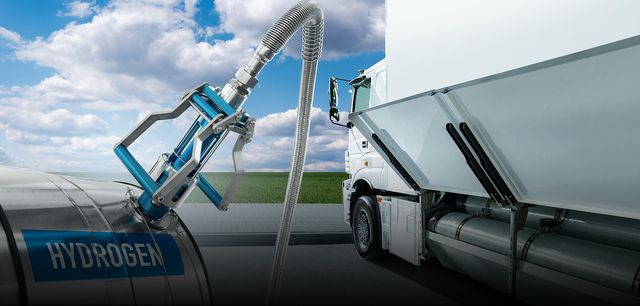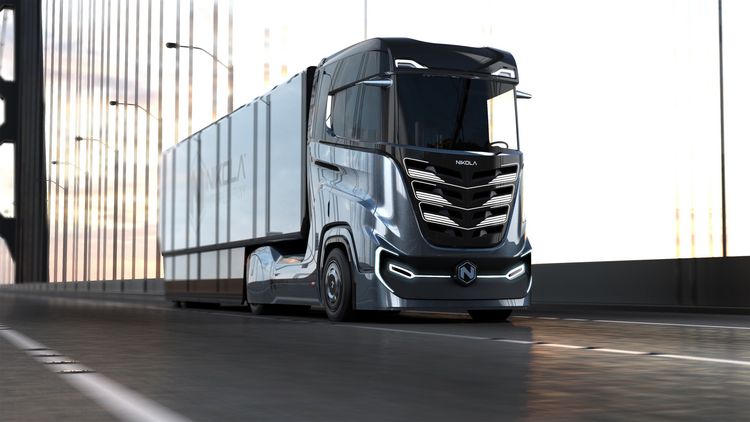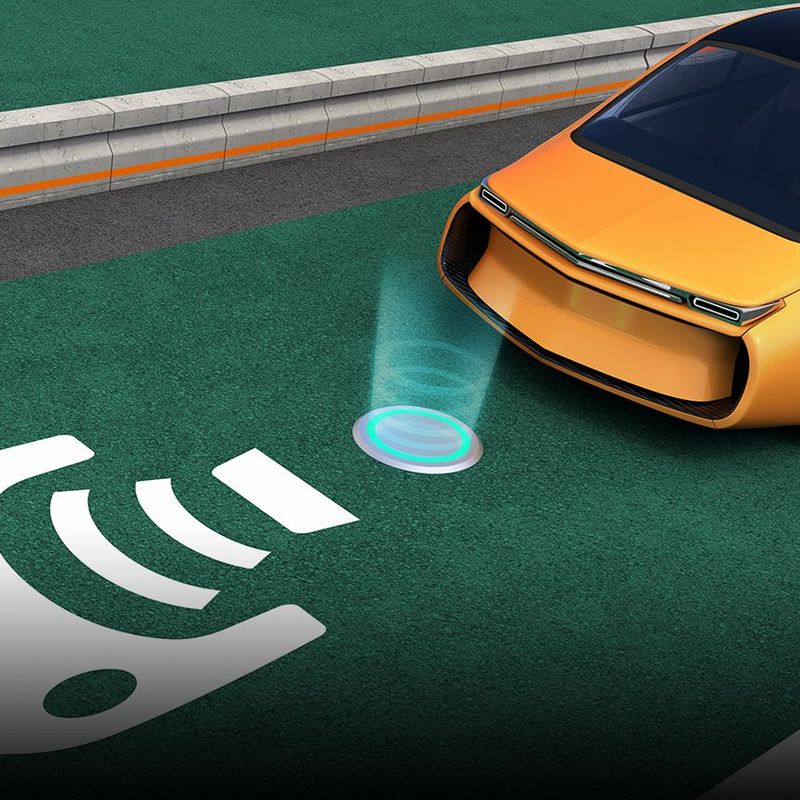27. January 2022
2021 was the year in which electromobility finally arrived in force. More than one in eight new vehicles sold were fully electric. But goods transport by road is also slowly making the switch to electrical power: ever larger numbers of manufacturers are building battery-driven lorries – now also for the HGV sector and with increasing range. The first fuel cell lorries are already on the road in Switzerland and under development in other places.
In the southern German city of Ulm, they are busy working on the future of heavy goods transport. It is here that Italian truck builder Iveco opened its new plant in September 2021, in a joint venture with US start-up Nikola. Since the turn of the year, the all-electric Nikola Tre has been rolling off the assembly line. This electric HGV claims to have a range of up to 560 kilometres on a single charge. The first takers were in the US, followed by Europe. At the end of 2021, Nikola delivered the first e-trucks to customers in its native land. They have been pressed into service in the ports of Los Angeles and Long Beach. The port of Hamburg is lined up to be the pilot customer in Europe. Trials of 25 of these battery-powered lorries are scheduled for this year.
In the medium term, the Iveco assembly line in Ulm is to turn out 3,000 lorries per year. And these will not be limited to purely battery-powered models: as of mid-2023, the plan is for the series production of hydrogen-fuelled versions of the Nikola Tre, whose electric axle will be supplied with electricity from a fuel cell system. The manufacturer lists two advantages of this model over the battery-powered version: it is quicker to refuel and offers a higher combined range of up to 800 kilometres on one charge. As far as range is concerned, Nikola still has major ambitions: the end of 2024 has been scheduled as the start of series production of the Nikola Two FCEV fuel cell lorry, which, with a range of some 1,450 kilometres, will be deployed on long-distance routes.
© picture allianceThe brand-new Nikola Tre electricity-powered heavy-duty truck will be supplemented as of 2023 by a hydrogen model whose electric motor is powered by a fuel cell.
The pressure is growing
Political pressure on the truck industry is growing: In 2018, lorries and buses were responsible for over a quarter of all emissions in the transport sector, even though they account for only a small proportion of the overall number of vehicles. The intention is therefore for new vehicles produced as of 2025 to emit 15 percent less carbon dioxide on average than was the case in 2019. By 2030, as stipulated in EU directives, this figure will need to be 30 percent lower. The expectation is for further tightening of the EU’s fleet limit values for heavy goods vehicles to take place in 2022. For its part, German climate protection law envisages that a third of all the distance covered by HGVs will by 2030 be accounted for by fully electric vehicles or electricity-based fuels like hydrogen or e-fuels.
Who is currently building with batteries?
With all this in view, it should come as no surprise that all the established truck builders have suddenly discovered alternatives to the combustion of fossil fuels: When it comes to urban, delivery and regional traffic, most of the developments currently favour electricity. Volvo already has no fewer than five models in its range for these areas. In the course of this year, this number will be added to by an electric 44-ton truck with a range of 300 kilometres. The declared aim of the Swedish truck builder is for half of all the Volvo lorries sold to be electric by 2030. Renault Trucks, which is working with Volvo on the development of battery systems, is currently building electric lorries ranging in size from 3.1 to 26 tons for urban, delivery and distribution transport and refuse collection. The idea is for these to be joined in 2023 by an articulated lorry which will then cover the regional and nationwide routes. It was back in October last year that Daimler Trucks started turning out its first electric lorry model: the Mercedes E-Actros which, with a range of up to 400 kilometres, is intended for distribution transport.
© picture allianceReady to charge: The E-Actros electric truck from Mercedes-Benz Trucks has a range of up to 400 kilometres with its 105 kWh batteries.
When might electric lorries pay for themselves?
Particularly when it comes to urban transport, electric lorries have a clear advantage over their diesel counterparts: thanks to their quiet motors, they can also be used to make night-time deliveries. And, according to a study of the Fraunhofer Institute commissioned by the Transport & Environment (T&E) environmental association, even with their current ranges they are already capable of managing all the existing routes in urban settings and half of all routes in regional transport. It is, of course, still true that the procurement costs for such lorries are significantly higher: for instance, an electric Actros is about three times more expensive than its diesel counterpart. Even so, thanks to their low operating costs, they may already in some cases be cheaper than diesel trucks – at least, as the Fraunhofer study reports, if they cover enough distance on any given day. Urban transport, with its short routes of fewer than 200 kilometres, would not yet make such expensive acquisitions viable, the report concludes. However, in regional transport with daily distances exceeding 500 kilometres, many vehicles would even now save considerable sums of money compared to their diesel counterparts, say the study’s authors.
But they would be dependent on current subsidies. For instance, the federal government presently shoulders 80 percent of the additional costs for vehicles and charging infrastructure. Not only that, but electric lorries are exempt from motorway toll payments. In the future, the prices of electric lorries look set to fall. Given the rising cost of diesel, the Fraunhofer researchers hold out the prospect that they might be able to hold their own against conventional lorries even without subsidies.
What is doing the long-distance haulage?
When it comes to environmentally friendly long-haul transport, the strategies of the different manufacturers tend to diverge: Hyundai, for instance, is placing all of its reliance on hydrogen. A test fleet of its first hydrogen-powered trucks with a range of 400 kilometres has been on the road in Switzerland since 2020. At the same time, the Korean company is also developing a fuel cell towing vehicle with a range of 1,000 km for long-distance transport. Renault, too, is aiming to launch a hydrogen-powered lorry for long-distance haulage by the middle of the decade. Daimler’s initial plans revolve around an electric 40-tonner for long-haul transport with a range of 500 kilometres. This is already sufficient for many plannable routes – assuming the existence of an effective charging infrastructure en route. When it comes to long-distance transport over several days and transports that are difficult to plan, Daimler intends to cover the demand with a fuel-cell-powered HGV that will keep pace with a standard diesel in terms of both refuelling and performance.
„The high battery weight eats into the vehicle’s actual cargo capacity – and, alongside availability, that’s a critical factor for haulage companies."
Advantages on long-distance routes
Over long distances, state-of-the-art fuel cell lorries offer a decisive advantage over purely battery-operated trucks, explains Manuel Hagemann, an electric mobility expert at TÜV NORD: “The high battery weight eats into the vehicle’s actual cargo capacity – and, alongside availability, that’s a critical factor for haulage companies. Electric lorries are allowed to weigh two tons more than diesel trucks to compensate for their heavy batteries. Studies confirm that battery packs for electric lorries for use in urban and regional transport, such as the Mercedes E-Actros, do not reach this threshold. However, when it comes to bigger batteries for longer ranges, this weight limit is quickly exceeded. “Here it remains to be seen whether this weight handicap and the space taken up by the batteries will be balanced out by future progress in battery technology,” Hagemann says.
Tesla and Tracton drawing up plans for battery vehicles
Electric car pioneer Tesla is making optimistic noises in this regard and placing all its faith in electricity for long-distance haulage too. After repeated delays, the Semi electric HGV should start rolling off the assembly line in 2023 and offer a range of over 1,000 kilometres. Traton, VW’s commercial vehicle subsidiary, has in the meantime moved virtually all its eggs into the battery basket. The decisive argument of Traton boss Matthias Gründler is based on the higher efficiency and lower operating costs of an electric lorry when compared to a diesel or a fuel cell truck, both which come ever more strongly to the fore, the longer the distances involved. This is because, whereas the electricity from the battery flows directly to the electric drive system, green hydrogen first has to be produced with the aid of renewable electricity and then converted back into electricity in a fuel cell. “For this reason, a fuel cell vehicle needs about two-and-a-half times as much primary energy for the same distance travelled as a purely battery-powered vehicle,” explains TÜV NORD expert Manuel Hagemann. What this means, of course, depending on the infrastructure in question, is higher refilling costs per kilometre – even if green hydrogen should end up being produced in large quantities in the future.
Traton subsidiary MAN intends to start series production of electric HGVs in 2024. With an initial range of 500 kilometres, these electric trucks should in the future be able to manage 700 to 1,000 kilometres on a single charge. Traton boss Matthias Gründler is convinced that, in terms of the overall costs, an electric HGV in Europe might be able to overtake its diesel counterpart by as early as the middle of this decade. This would, however, require a comprehensive nationwide fast-charging infrastructure, which would allow the traction batteries of the electric trucks to be charged up within the statutory rest period of 45 minutes per 4.5 hours driving time.
© Stack PictureHeavy-duty traffic clogs the roads - and pollutes the environment. Truck builders are therefore turning to e-trucks, which are gaining more and more range.
Improving charging
At the moment, improvements in charging exist only on paper. It is true that the fast-charging grid for electric vehicles has become significantly denser in recent years. “But standard charging stations are designed for cars. Lorries are generally simply too big to fit into the parking bays,” TÜV NORD expert Hagemann finds. It’s for this reason that Traton, Volvo and Daimler Trucks all want to build up a public network with 1,700 charging points for lorries and intercity coaches. The manufacturers see their initiative as a first step. It’s now up to the policymakers to kick-start the development of a comprehensive charging network in the EU.
According to European auto association ACEA, 15,000 high-speed charging points will be needed for electric commercial vehicles by 2025, with the number set to rise to 50,000 by 2030. Many of these will have to be megawatt chargers capable of quickly recharging the giant batteries to be found in lorries. “For electric long-distance transport there’s no getting around the need for megawatt charging capacity,” Manuel Hagemann confirms. At one megawatt, electric charging points would be three times faster than the most powerful chargers currently available for electric cars. To push the development of the new technology, a pilot project was launched in Germany in September last year. By 2024, the first megawatt chargers for e-trucks are to be installed and tested in practice along the A2 motorway and at logistics centres in Berlin and Dortmund to create the blueprint for a nationwide high-performance charging network.
The slow trek to hydrogen
When it comes to public hydrogen filling stations, too, there is a lot of catching up to be done. “It’s also often not yet possible to fill up commercial vehicles at these filling stations,” says TÜV NORD expert Hagemann. And that's also a question of the pressure. “Many of the existing filling stations operate with a pressure of 700 bar, as required by passenger cars. But most modern commercials operate with 350 bar,” says Hagemann by way of summary of the problem. Last but not least, according to researchers at the Fraunhofer Institute, existing filling stations can’t provide the quantities of hydrogen needed to quickly fill the large tanks of HGVs. A dedicated filling station infrastructure would be needed specifically for lorries, Hagemann says. If every HGV in Germany were to run on hydrogen, this would require the construction of 140 filling stations across the country by 2050, the scientists estimate. Their calculations suggest annual costs of some nine billion euros. The simple truth is that environmentally friendly transport of tomorrow requires major investment today.
About Manuel Hagemann
© TÜV NORD
Manuel Hagemann is a technical expert for electromobility at TÜV NORD. In the TÜV Association, the mechanical engineer heads the Electromobility Working Group.







